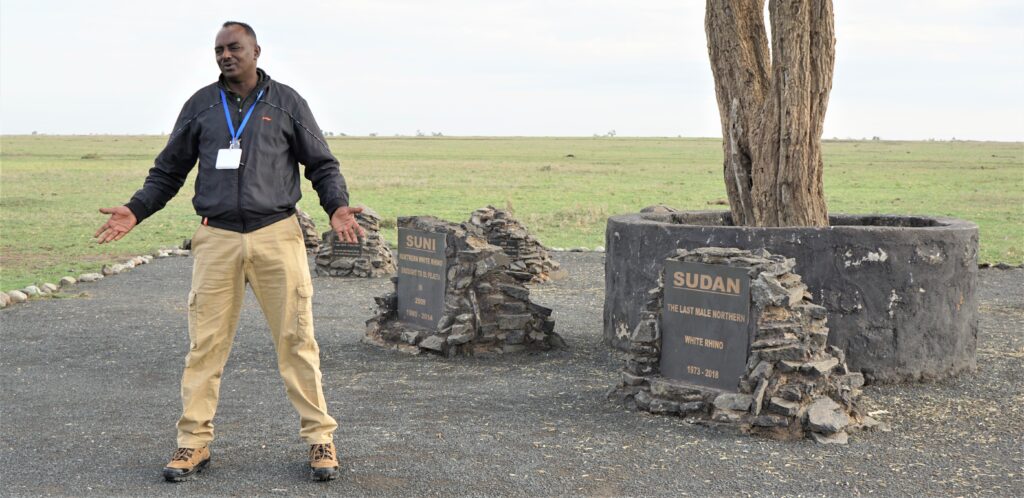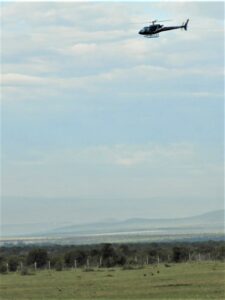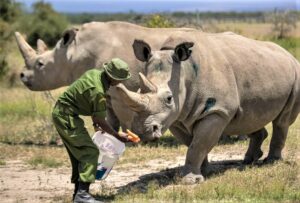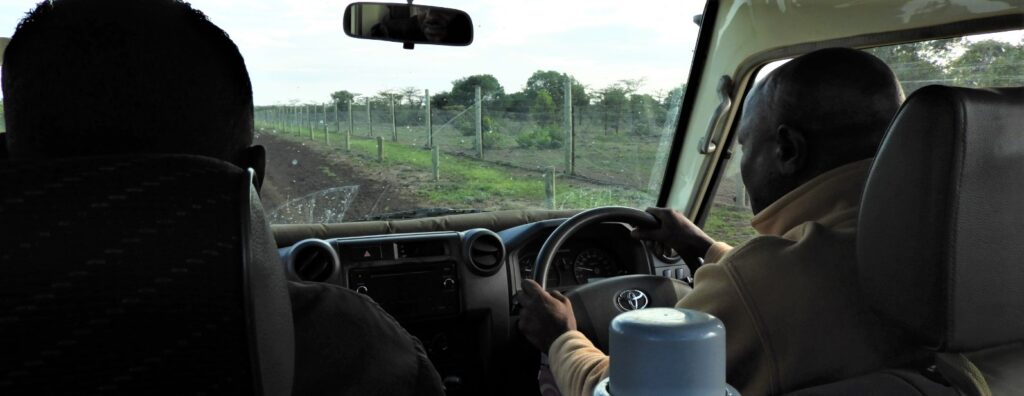» posted on Tuesday, September 13th, 2022 by Linda Lou Burton
What a Shame
Linda Lou Burton posting from Sweetwaters Serena Camp, Ol Pejeta Conservancy, Nanyuki, Kenya – Sixteen gravestones; one lone tree. We’d stopped at the Rhino Cemetery, set up as a memorial honoring the lives of Ol Pejeta rhinos killed in the poaching epidemic since 2004. Abdi stood beside the gravestone of Sudan as he told us the story of the last Northern White Male Rhino on Planet Earth. That’s right, Sudan’s death in 2018 brought the end to a species; there before our eyes was a cold hard illustration of the meaning of the word EXTINCT. Hard to grasp. How does such a thing happen?
 Sudan wasn’t killed by poachers; he was guarded and cared for 24/7 during the last years of his life at Ol Pejeta and died of health-related issues at age 45. But every Northern White Male Rhino before him was already gone. The group of us walked around, solemn, reading the name and cause of death on the other gravestones.
Sudan wasn’t killed by poachers; he was guarded and cared for 24/7 during the last years of his life at Ol Pejeta and died of health-related issues at age 45. But every Northern White Male Rhino before him was already gone. The group of us walked around, solemn, reading the name and cause of death on the other gravestones.
Loita. Male. Killed by poison dart. Both horns taken. Chema. Female. Snared and found dead with both horns missing. Mia. Female. Shot dead. Both horns removed. Shemsha. Female. Shot dead. Both horns removed. Kaka. Male. Killed by poison dart. Both horns taken. Ishirini. Female. Killed by poison arrow. Found writhing in pain with horns chopped off. She was 12 months pregnant.
Back in our 4×4, Abdi and Daniel fielded our questions; why is rhino horn so valuable and who is buying it? Asian markets, mainly; medicinal purposes? Prestige? It sells for more than cocaine or diamonds, and poachers show no mercy — the HORN is all they want; animals may be left to bleed to death. There are less than 25,000 rhinos left in Africa. Approximately 2,000 rhino horns went into illegal trade just last year. These numbers are jarring; I shake my head in disbelief. Just ahead a mother and baby rhino are feeding peacefully; Daniel slows.
 Then the noise of a chopper overhead, patrolling the vast acreage of Ol Pejeta. The rhinos didn’t notice, but I did; I was pleased to know they are being watched over so diligently. There are about 140 of the critically endangered black rhinos living here now; it’s the largest black rhino sanctuary in East Africa.
Then the noise of a chopper overhead, patrolling the vast acreage of Ol Pejeta. The rhinos didn’t notice, but I did; I was pleased to know they are being watched over so diligently. There are about 140 of the critically endangered black rhinos living here now; it’s the largest black rhino sanctuary in East Africa.
Ol Pejeta also has 39 southern white rhinos. There is no color difference between white and black rhinos; the name is a mistranslation of the Afrikaans word ‘weit’ meaning ‘wide’ – which refers to their square shaped lips used for grazing. This is the main distinction between white rhino and black. Can you tell if this browsing pair are black, or white? I can’t!
 “This is the secured enclosure,” Daniel said, as he drove beside a double-wired fence. It surrounds the 700-acre 24-hr armed security area that is home to the last two northern white rhinos in the world. Najin and Fatu, mother and daughter, live here, pampered and cared for with a nutritious diet and everything else they need. Continuation of the northern white species ended with the death of Sudan in 2018; these last two girls can’t do it on their own. I found a photo of them (online) getting carrots from their keeper; living out their years as the last of their kind.
“This is the secured enclosure,” Daniel said, as he drove beside a double-wired fence. It surrounds the 700-acre 24-hr armed security area that is home to the last two northern white rhinos in the world. Najin and Fatu, mother and daughter, live here, pampered and cared for with a nutritious diet and everything else they need. Continuation of the northern white species ended with the death of Sudan in 2018; these last two girls can’t do it on their own. I found a photo of them (online) getting carrots from their keeper; living out their years as the last of their kind.
What a shame.
Ol Pejeta Conservancy, and What They’re Doing About Rhinos https://www.olpejetaconservancy.org/wildlife/rhinos/

